 历史照片展示了1948年英军撤离前巴勒斯坦的生活
历史照片展示了1948年英军撤离前巴勒斯坦的生活
Historical photos show life in Palestine before the withdrawal of British troops in 1948
译文简介
20世纪初,巴勒斯坦拥有成功的进出口产业。
正文翻译
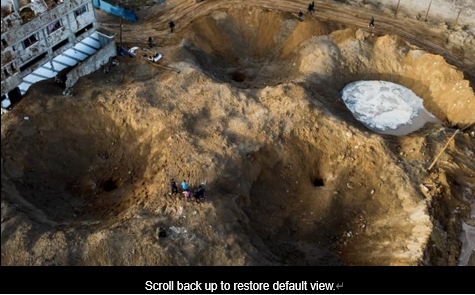
Palestine had a successful importing and exporting industry at the beginning of the 20th century.
20世纪初,巴勒斯坦拥有成功的进出口产业。
The expansion of railroads throughout Palestine to neighboring countries helped the region's growth in business.
巴勒斯坦铁路的扩建连接了周边国家,促进了该地区商业的增长。
巴勒斯坦铁路的扩建连接了周边国家,促进了该地区商业的增长。
The British occupation of Palestine created tension amongst citizens and soldiers.
英国占领巴勒斯坦引发了民众和士兵之间的紧张局势。
英国占领巴勒斯坦引发了民众和士兵之间的紧张局势。
At the end of World War I, the British occupied the formerly Ottoman-controlled Palestine and declared the establishment in Palestine of a national home for Jewish people. For the next two decades, over 100,000 Jews entered Palestine.
Tensions reached their boiling point after the British withdrew from Palestine in 1948 and the Arab-Israeli War began.
Despite moments of heavy tension and conflict within Palestine during British occupation, life and commerce continued. Historical photos offer a glimpse into everyday life in Palestine before the withdrawal of British troops.
In the 1920s, Jerusalem started to become an important commercial center.
在第一次世界大战结束时,英国占领了之前由奥斯曼帝国控制的巴勒斯坦,并宣称在巴勒斯坦建立一个供犹太人居住的国家。在接下来的二十年里,超过100,000名犹太人进入了巴勒斯坦。
1948年英国从巴勒斯坦撤军,阿以战争爆发后,紧张局势达到了沸点。
尽管在英国占领期间的巴勒斯坦存在紧张和冲突的时刻,但生活和商业仍在继续。历史照片展示了英军撤离之前巴勒斯坦的日常生活。
20世纪20年代,耶路撒冷开始成为一个重要的商业中心。
Tensions reached their boiling point after the British withdrew from Palestine in 1948 and the Arab-Israeli War began.
Despite moments of heavy tension and conflict within Palestine during British occupation, life and commerce continued. Historical photos offer a glimpse into everyday life in Palestine before the withdrawal of British troops.
In the 1920s, Jerusalem started to become an important commercial center.
在第一次世界大战结束时,英国占领了之前由奥斯曼帝国控制的巴勒斯坦,并宣称在巴勒斯坦建立一个供犹太人居住的国家。在接下来的二十年里,超过100,000名犹太人进入了巴勒斯坦。
1948年英国从巴勒斯坦撤军,阿以战争爆发后,紧张局势达到了沸点。
尽管在英国占领期间的巴勒斯坦存在紧张和冲突的时刻,但生活和商业仍在继续。历史照片展示了英军撤离之前巴勒斯坦的日常生活。
20世纪20年代,耶路撒冷开始成为一个重要的商业中心。
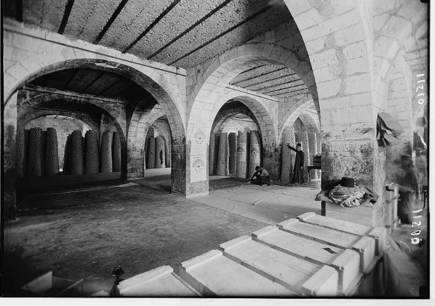
The Nablus soap stock room where soap is stacked to dry.Matson photograph collection via Library of Congress.
纳布卢斯的肥皂储存室,那里的肥皂被堆放晾干。马特森摄影收藏,国会图书馆。
原创翻译:龙腾网 https://www.ltaaa.cn 转载请注明出处
In the 1920s, Jerusalem grew its reputation as a key commercial center, in tandem with the coastal cities of Jaffa and Gaza, which helped with the importing and exporting of goods.
Palestine became a trading hub, trading soap, grain, and cotton to Europe, Africa, and the Middle East.
Gaza and Jaffa imported goods from Egypt, Istanbul, China, India, and France.
Palestine utilized the new influx of commerce to build roads and railroads that connected Jerusalem to other ports and cities.
在20世纪20年代,耶路撒冷与海滨城市雅法和加沙一起成为一个重要的商业中心,协助进出口商品。巴勒斯坦成为一个贸易中心,向欧洲、非洲和中东出口肥皂、谷物和棉花。加沙和雅法从埃及、伊斯坦布尔、中国、印度和法国进口商品。巴勒斯坦利用新增加的商业流入来修建连接耶路撒冷与其他港口和城市的道路和铁路。
Palestine became a trading hub, trading soap, grain, and cotton to Europe, Africa, and the Middle East.
Gaza and Jaffa imported goods from Egypt, Istanbul, China, India, and France.
Palestine utilized the new influx of commerce to build roads and railroads that connected Jerusalem to other ports and cities.
在20世纪20年代,耶路撒冷与海滨城市雅法和加沙一起成为一个重要的商业中心,协助进出口商品。巴勒斯坦成为一个贸易中心,向欧洲、非洲和中东出口肥皂、谷物和棉花。加沙和雅法从埃及、伊斯坦布尔、中国、印度和法国进口商品。巴勒斯坦利用新增加的商业流入来修建连接耶路撒冷与其他港口和城市的道路和铁路。
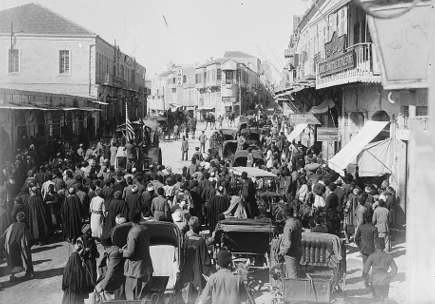
People crowd around a steamroller rolling down Jerusalem street.Matson photograph collection via Library of Congress.
人们聚集在耶路撒冷街道上,看着一台蒸汽压路机行驶。照片来自马特森摄影收藏,通过美国国会图书馆提供。
When railroads started being constructed in Palestine in the late 19th and early 20th century, connections became easier and faster, and employment opportunities grew. The trains connected Palestine to neighboring African, Asian, and European markets in a different way than their ports could.
Produce was bountiful and available to buy on a small or large scale.
19世纪末和20世纪初,当铁路开始在巴勒斯坦修建时,交通变得更加便捷和快速,就业机会也增加了。这些火车以与港口不同的方式将巴勒斯坦与邻近的非洲、亚洲和欧洲市场连接起来。
农产品丰富,并且可以以小规模或大规模购买。
Produce was bountiful and available to buy on a small or large scale.
19世纪末和20世纪初,当铁路开始在巴勒斯坦修建时,交通变得更加便捷和快速,就业机会也增加了。这些火车以与港口不同的方式将巴勒斯坦与邻近的非洲、亚洲和欧洲市场连接起来。
农产品丰富,并且可以以小规模或大规模购买。
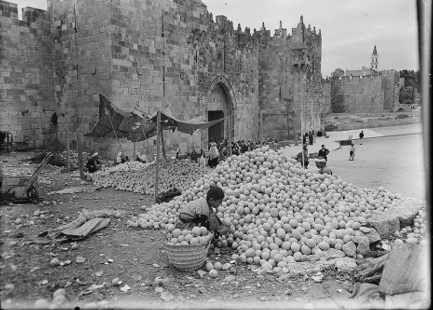
A boy collects Palestinian oranges at Damascus gate.Matson photograph collection via Library of Congress.
一个男孩在大马士革门收集巴勒斯坦的橙子。照片来自马特森摄影收藏,通过美国国会图书馆提供。
It was sold at outdoor markets or processed in factories to be sold.
Investments from neighboring countries solidified a strong trade economy.
这些橙子在露天市场上出售,或者被加工成产品后销售。来自邻国的投资巩固了强大的贸易经济。
Investments from neighboring countries solidified a strong trade economy.
这些橙子在露天市场上出售,或者被加工成产品后销售。来自邻国的投资巩固了强大的贸易经济。
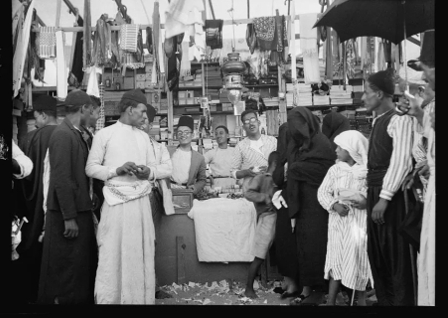
A typical dry goods stall in Nebi Rubin (The Prophet Reuben), Southern Palestine.Matson photograph collection via Library of Congress.
巴勒斯坦南部的尼比鲁宾(先知鲁本)地区的一家典型杂货摊。照片来自马特森摄影收藏,通过美国国会图书馆提供。
People would come to work for trade in the city or on the railways.
Locals ran food markets and bakeries.
人们会前来城市或铁路工作进行贸易。当地人经营着食品市场和面包店。
Locals ran food markets and bakeries.
人们会前来城市或铁路工作进行贸易。当地人经营着食品市场和面包店。
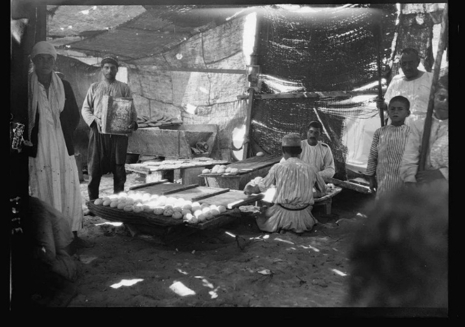
A bakery in Nebi Rubin (The Prophet Reuben) in Southern Palestine.Matson photograph collection via Library of Congress.
在巴勒斯坦南部的尼比鲁宾(先知鲁宾)地区的一家面包店。照片来自马特森摄影收藏,通过美国国会图书馆提供。
People went about their daily lives, buying groceries and interacting with their neighbors.
人们过着日常生活,购买杂货,与邻居互动
人们过着日常生活,购买杂货,与邻居互动
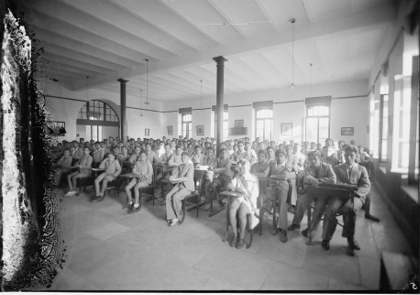
A Palestinian baker sells bread to a customer.Matson photograph collection via Library of Congress
一位巴勒斯坦面包师向一位顾客销售面包。照片来自马特森摄影收藏,通过美国国会图书馆提供。
The Friends of Ramallah, a Quaker organization, opened up schools for children.
拉马拉的朋友(一个贵格会组织)为儿童开设了学校。
拉马拉的朋友(一个贵格会组织)为儿童开设了学校。
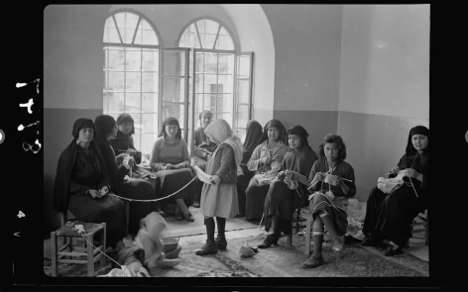
Children at the Ramallah Quaker Mission School.Matson photograph collection via Library of Congress.
在兰马拉贵格会传教学校的儿童。照片来自马特森摄影收藏,通过美国国会图书馆提供。
A number of small schools were opened in different villages for girls in 1869. Later, the Friends of Ramallah would open a "Girls Training Home of Ramallah," where girls from neighboring cities could stay and learn.
The Friends of Ramallah began the boys' school in 1901 which was on a different site than the girls' school. However, for an hour and a half each week, the boys and girls would engage in co-educational classes.
Women of different ages would gather to knit and spin wool at the Women's Institute.
1869年,不同的村庄开设了许多小型女子学校。后来,兰马拉的朋友们将开设“兰马拉女子培训中心”,邻近城市的女孩可以在这里学习和居住。
1901年,兰马拉的朋友开始了男子学校,地点与女校不同。不过,这些男孩和女孩每周要花一个半小时参加男女同校的课程。
不同年龄的妇女会聚集在妇女学院编织和纺羊毛。
The Friends of Ramallah began the boys' school in 1901 which was on a different site than the girls' school. However, for an hour and a half each week, the boys and girls would engage in co-educational classes.
Women of different ages would gather to knit and spin wool at the Women's Institute.
1869年,不同的村庄开设了许多小型女子学校。后来,兰马拉的朋友们将开设“兰马拉女子培训中心”,邻近城市的女孩可以在这里学习和居住。
1901年,兰马拉的朋友开始了男子学校,地点与女校不同。不过,这些男孩和女孩每周要花一个半小时参加男女同校的课程。
不同年龄的妇女会聚集在妇女学院编织和纺羊毛。
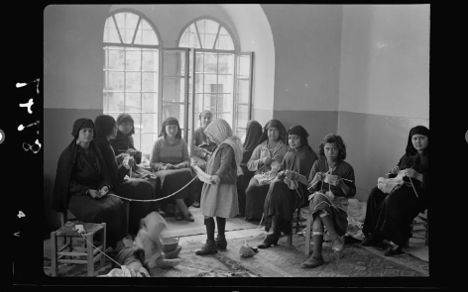
Arab women of the Women's Institute in Old City.Matson photograph collection via Library of Congress
老城区妇女学院的阿拉伯妇女。照片来自马特森摄影收藏,通过美国国会图书馆提供。
There were still constant reminders of the presence of a foreign occupier throughout the first half of the 20th century.
在20世纪上半叶,外来占领者的存在仍然时常提醒着人们。
在20世纪上半叶,外来占领者的存在仍然时常提醒着人们。
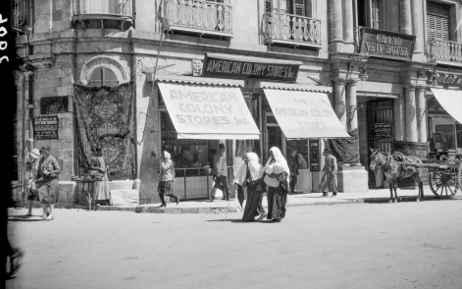
Two women walk in front of an American market in Palestine.Matson photograph collection via Library of Congress.
两位妇女走在巴勒斯坦一家美国市场前面。照片来自马特森摄影收藏,通过美国国会图书馆提供。
Despite a booming trade economy, British occupation still loomed heavily in the streets of Palestinian cities.
After the defeat of the Ottoman Empire in 1917, the British took control of Palestine and occupied the region for 30 years.
The British occupation also began the establishment in Palestine of a "national home for the Jewish people," mandated by the Balfour Declaration, named after British Foreign Secretary Arthur Balfour.
Despite the civil unrest lurking in Palestine, there was also a sense of normal day-to-day life.
虽然贸易经济蓬勃发展,但英国的占领仍然严重威胁着巴勒斯坦城市的街道。
在1917年奥斯曼帝国的战败后,英国接管了巴勒斯坦,并占领该地区长达30年。
英国占领还开始在巴勒斯坦建立一个“犹太人民族家园”,这是《贝尔福宣言》(Balfour Declaration)的规定,该宣言以英国外交大臣阿瑟·贝尔福(Arthur Balfour)的名字命名。
尽管巴勒斯坦潜伏着内乱,但也有一种日常生活正常的感觉。
After the defeat of the Ottoman Empire in 1917, the British took control of Palestine and occupied the region for 30 years.
The British occupation also began the establishment in Palestine of a "national home for the Jewish people," mandated by the Balfour Declaration, named after British Foreign Secretary Arthur Balfour.
Despite the civil unrest lurking in Palestine, there was also a sense of normal day-to-day life.
虽然贸易经济蓬勃发展,但英国的占领仍然严重威胁着巴勒斯坦城市的街道。
在1917年奥斯曼帝国的战败后,英国接管了巴勒斯坦,并占领该地区长达30年。
英国占领还开始在巴勒斯坦建立一个“犹太人民族家园”,这是《贝尔福宣言》(Balfour Declaration)的规定,该宣言以英国外交大臣阿瑟·贝尔福(Arthur Balfour)的名字命名。
尽管巴勒斯坦潜伏着内乱,但也有一种日常生活正常的感觉。
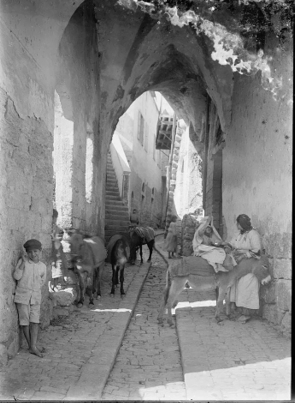
Old City Street, Nazareth.Matson photograph collection via Library of Congress.
纳撒勒古城街道。照片来自马特森摄影收藏,通过美国国会图书馆提供。
By the middle of the century, the British left Palestine and left the Arab and Jewish populations to settle land disputes on their own. The time leading up to their withdrawal was filled with bombings, protests, and demonstrations. Despite the turmoil that filled those years, photos of Palestine during that time offer glimpses of day-to-day life in markets, homes, and businesses.
到了世纪中期,英国离开了巴勒斯坦,并让阿拉伯和犹太人民议定自己的土地争端。
在英国撤军前的那段时间充满了爆炸、抗议和示威。尽管这些年充满了动荡,但当时巴勒斯坦的照片提供了市场、家庭和企业日常生活的一瞥。
到了世纪中期,英国离开了巴勒斯坦,并让阿拉伯和犹太人民议定自己的土地争端。
在英国撤军前的那段时间充满了爆炸、抗议和示威。尽管这些年充满了动荡,但当时巴勒斯坦的照片提供了市场、家庭和企业日常生活的一瞥。
评论翻译
很赞 ( 7 )
收藏
I don't have much to say about the whole conflict going on right now, I just don't know enough about it all. I do know anytime people are killed by acts of violence, doesn't matter who it is, it is just sad. Not profound I know, but I am not trying to be.
我对当前的冲突没有太多要说的,因为我对这一切还不够了解。我知道,每当有人因暴力行为而丧生,不管是谁,都是令人悲伤的。我知道这并不是什么深奥的见解,但我并不打算如此。
原创翻译:龙腾网 https://www.ltaaa.cn 转载请注明出处
Wouldn’t it be great if there were no wars and everyone could travel to different countries and learn their cultures, eat the local food and enjoy meeting people. My wife and I at one time traveled all over to do just that. But in the past 10 + years it’s been rather scary.
如果没有战争,每个人都可以去不同的国家旅行,了解他们的文化,品尝当地美食,享受结识新人的乐趣,那将是多么美好啊。我和妻子曾经为此四处旅行。但在过去的10多年里,情况变得相当可怕。
Palestine was part of the Ottoman empire which sided with the Central powers in WW1 and lost.
The British utilized help from Jews and Arabs to beat the Ottoman empire. The support by BOTH Jews and Arabs contributed to British victory and demonstrated the local resentment against the Ottoman empire. ( not exactly a peaceful place before the British )
Britain partitioned the land which didn't quite satisfy everyone resulting in multiple wars.
One important fact to note is that in all those Israeli-Arab wars , Israel fought Egypt , Syria, and Jordan NOT Palestine. Many Arab states WANTED Palestine as their province , not to give them statehood. Negotiating with Israeli would ACTUALLY have granted Palestinians statehood. ( Emphasis here! )
巴勒斯坦曾是奥斯曼帝国的一部分,奥斯曼帝国在第一次世界大战中站在同盟国一边,但失败了。
英国利用犹太人和阿拉伯人的帮助打败了奥斯曼帝国。犹太人和阿拉伯人的支持为英国的胜利做出了贡献,并显示了当地对奥斯曼帝国的不满。(在英国到来之前,这里并不是一个和平的地方)
英国将这片土地划分,但并未完全满足所有人的需求,导致了多次战争。
一个重要的事实需要注意的是,在所有以色列与阿拉伯国家的战争中,以色列与埃及、叙利亚和约旦作战,而不是巴勒斯坦。许多阿拉伯国家希望将巴勒斯坦作为自己的一部分,而不是给予他们独立国家的地位。与以色列进行谈判实际上会给巴勒斯坦人提供国家的地位。(强调此点!)
Anybody else wonder what Gaza and the West bank would look like today if the palestinians had stuck with the Oslo accords and Israel hadn't expanded settlements in the Jordan Valley?
还有其他人想知道如果巴勒斯坦人坚持奥斯陆协议,以色列没有在约旦河谷扩建定居点,今天加沙地带和西岸会是什么样子吗?
The UN brokered a deal between Palistine and Israel before the British left to recognize Palistine as an independent country but the Palistinians refused to recognize it and walked away. The Palistinians walked away again when President Carter brokered another deal. It was a sweetheart deal for Palistine but they walked away again.
联合国在英国撤离之前曾在巴勒斯坦和以色列之间进行了调解,以承认巴勒斯坦作为一个独立国家,但巴勒斯坦人拒绝承认并离开了谈判。巴勒斯坦人在卡特总统进行另一次调解时再次离开了谈判。这对巴勒斯坦来说是一个非常优惠的协议,但他们还是再次放弃了。
When it comes to the real truth of human civilization there are only two peoples, the conquerors and the conquered. Any attempts to find a middle ground on this fact results in endless conflict.
现实情况是,在人类文明中,只有两种人群,征服者和被征服者。 任何试图在这一事实中寻找中间立场的努力都会导致无休止的冲突。
What an idyllic place, rainbow skies and marshmallow clouds. For contrast, show what Palestine looks like after Hamas came to power. The truth is, they destroyed any and everything that represented western influence.
多么田园诗般的地方,彩虹的天空和棉花糖般的云彩。相比之下,展示一下哈马斯掌权后巴勒斯坦的样子。事实是,他们摧毁了所有代表西方影响的事物。
As with so many such articles of Israel pre-1948, the author assumes that there were no Jews in the region before the Balfour Declaration. That is very wrong. Tens of thousands of Jews have lived in the Land of Israel since Biblical times. Just look it up.
和以色列建国前1948年的许多文章一样,作者假设在《贝尔福宣言》之前该地区没有犹太人。这是非常错误的。数万名犹太人自古以来就居住在以色列地区。你可以查一查。
原创翻译:龙腾网 https://www.ltaaa.cn 转载请注明出处